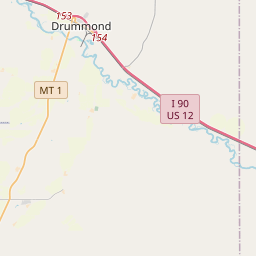Inscription
The Little Blackfoot Valley is filled with lush hay fields. You already may have noticed the rounded haystacks and commented on the strange lodgepole structures standing in many of the fields. This contraption that looks like a cross between a catapult and a cage is a hay-stacker that actually acts like a little of both. It was invented before 1910 by Dade Stephens and H. Armitage in the Big Hole Valley about sixty miles south of here. The device, called a beaver slide, revolutionized haying in Montana. It helped keep the wind from blowing the hay away and cut stacking time considerably.
To work the beaver slide, a large rake piled high with hay is run up the arms of the slide (the sloping portion of the "catapult"). At the top the hay dumps onto the stack. The side gates (the cage part) keep the stack in a neat pile and make it possible to stack higher. The sides were added to the system in the late 1940s. Although the lifting of the rake is usually powered by a take-off from a tractor, truck or car axle, on some operations horse teams still provide the rpm's to muscle the hay up the slide.
Aside from minor improvements, the beaver slide has remained unchanged since its inception. Once used throughout a good portion of the northern west, modern technology that can shape hay into bales, loaves or huge jelly rolls have replaced it in many areas. The Little Blackfoot is one of several valleys in Montana where you can still see the beaver slide and its distinctive haystacks.
To work the beaver slide, a large rake piled high with hay is run up the arms of the slide (the sloping portion of the "catapult"). At the top the hay dumps onto the stack. The side gates (the cage part) keep the stack in a neat pile and make it possible to stack higher. The sides were added to the system in the late 1940s. Although the lifting of the rake is usually powered by a take-off from a tractor, truck or car axle, on some operations horse teams still provide the rpm's to muscle the hay up the slide.
Aside from minor improvements, the beaver slide has remained unchanged since its inception. Once used throughout a good portion of the northern west, modern technology that can shape hay into bales, loaves or huge jelly rolls have replaced it in many areas. The Little Blackfoot is one of several valleys in Montana where you can still see the beaver slide and its distinctive haystacks.
Details
| HM Number | HM1D5P |
|---|---|
| Tags | |
| Marker Condition | No reports yet |
| Date Added | Tuesday, September 9th, 2014 at 10:24am PDT -07:00 |
Pictures
Locationbig map






| UTM (WGS84 Datum) | 12T E 373063 N 5161052 |
|---|---|
| Decimal Degrees | 46.59103333, -112.65706667 |
| Degrees and Decimal Minutes | N 46° 35.462', W 112° 39.424' |
| Degrees, Minutes and Seconds | 46° 35' 27.72" N, 112° 39' 25.44" W |
| Driving Directions | Google Maps |
| Area Code(s) | 406 |
| Closest Postal Address | At or near 191-199 Unnamed Road, Garrison MT 59731, US |
| Alternative Maps | Google Maps, MapQuest, Bing Maps, Yahoo Maps, MSR Maps, OpenCycleMap, MyTopo Maps, OpenStreetMap |
Is this marker missing? Are the coordinates wrong? Do you have additional information that you would like to share with us? If so, check in.
Nearby Markersshow on map
Maintenance Issues
- Is this marker part of a series?
- What historical period does the marker represent?
- What historical place does the marker represent?
- What type of marker is it?
- What class is the marker?
- What style is the marker?
- Does the marker have a number?
- What year was the marker erected?
- Who or what organization placed the marker?
- This marker needs at least one picture.
- Can this marker be seen from the road?
- Is the marker in the median?

Comments 0 comments